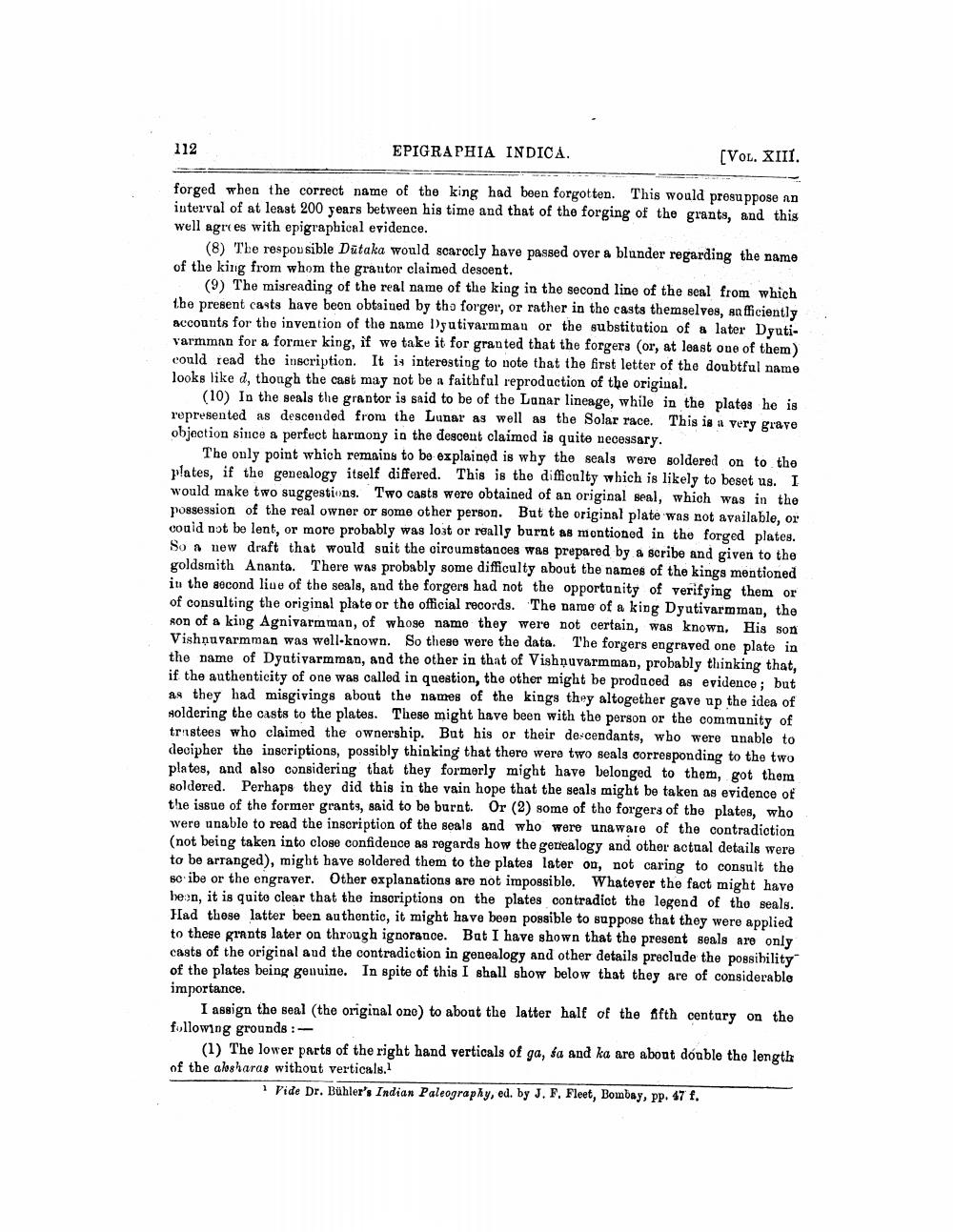________________
112
EPIGRAPHIA INDICA.
[VOL. XIII.
forged when the correct name of the king had been forgotten. This would presuppose an interval of at least 200 years between his time and that of the forging of the grants, and this well agrees with epigraphical evidence.
(8) The respou sible Dütaka would scarcely have passed over a blunder regarding the name of the king from whom the grantor claimed descent.
(9) The misreading of the real name of the king in the second line of the seal from which the present casts have been obtained by the forger, or rather in the casts themselves, Anfficiently accounts for the invention of the name Dsutivarmman or the substitution of a later Dyutivarmman for a former king, if we take it for granted that the forgers (or, at least one of them) could read the inscription. It is interesting to note that the first letter of the doubtful name looks like d, though the cast may not be a faithful reproduction of the original.
(10) In the seals the grantor is said to be of the Lunar lineage, while in the plates he is represented as descended from the Lunar as well as the Solar race. This is a very grave objection since & perfect harmony in the descent claimed is quite necessary.
The only point which remains to be explained is why the seals were soldered on to the plates, if the genealogy itself differed. This is the difficulty which is likely to beset us. I would make two suggestions. Two casts were obtained of an original seal, which was in the possession of the real owner or some other person. But the original plate was not available, or could not be lent, or more probably was lost or really burnt as mentioned in the forged plates. So a new draft that would suit the ciroumstances was prepared by a scribe and given to the goldsmith Ananta. There was probably some difficulty about the names of the kings mentioned in the second line of the seals, and the forgers had not the opportunity of verifying them or of consulting the original plate or the official records. The name of a king Dyutivarmman, the son of a king Agnivarmman, of whose name they were not certain, was known. His son Vishnuvarmman was well-known. So these were the data. The forgers engraved one plate in the name of Dyutivarmman, and the other in that of Vishnuvarmman, probably thinking that, if the authenticity of one was called in question, the other might be produced as evidence; but as they had misgivings about the names of the kings they altogether gave up the idea of Holdering the casts to the plates. These might have been with the person or the community of trustees who claimed the ownership. But his or their descendants, who were unable to decipher the inscriptions, possibly thinking that there were two seals corresponding to the two plates, and also considering that they formerly might have belonged to them, got them soldered. Perhaps they did this in the vain hope that the seals might be taken as evidence of the issue of the former grants, said to be burnt. Or (2) some of the forgers of the plates, who were unable to read the inscription of the seals and who were unaware of the contradiction (not being taken into close confidence as regards how the geriealogy and other actual details were to be arranged), might have soldered them to the plates later on, not caring to consult the Beibe or the engraver. Other explanations are not impossible. Whatever the fact might have bean, it is quite clear that the inscriptions on the plates contradict the legend of the seals. Had these latter been authentic, it might have been possible to suppose that they were applied to these grants later on through ignorance. Bat I have shown that the present seals are only casts of the original and the contradiction in genealogy and other details preclude the possibility of the plates being genuine. In spite of this I shall show below that they are of considerable importance.
I assign the seal (the original one) to about the latter half of the fifth century on the following grounds :
(1) The lower parts of the right hand verticals of ga, sa and ka are about double the length of the ahsharas without verticals.
i Vide Dr. Bühler's Indian Paleography, ed. by J. F. Fleet, Bombay, pp. 47 f.




